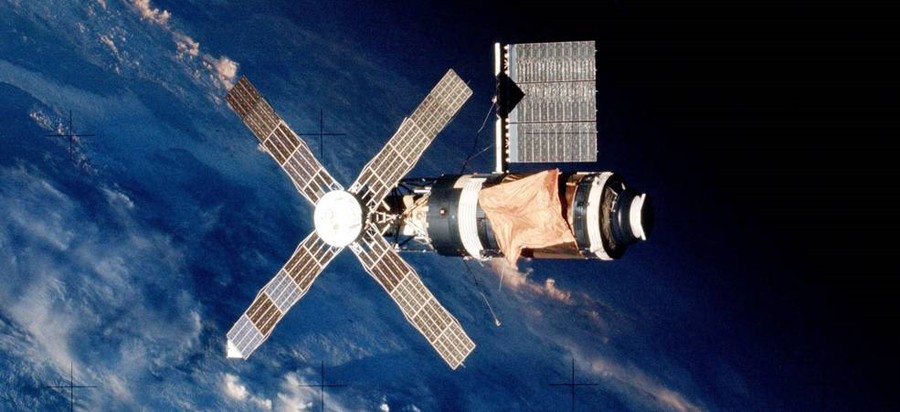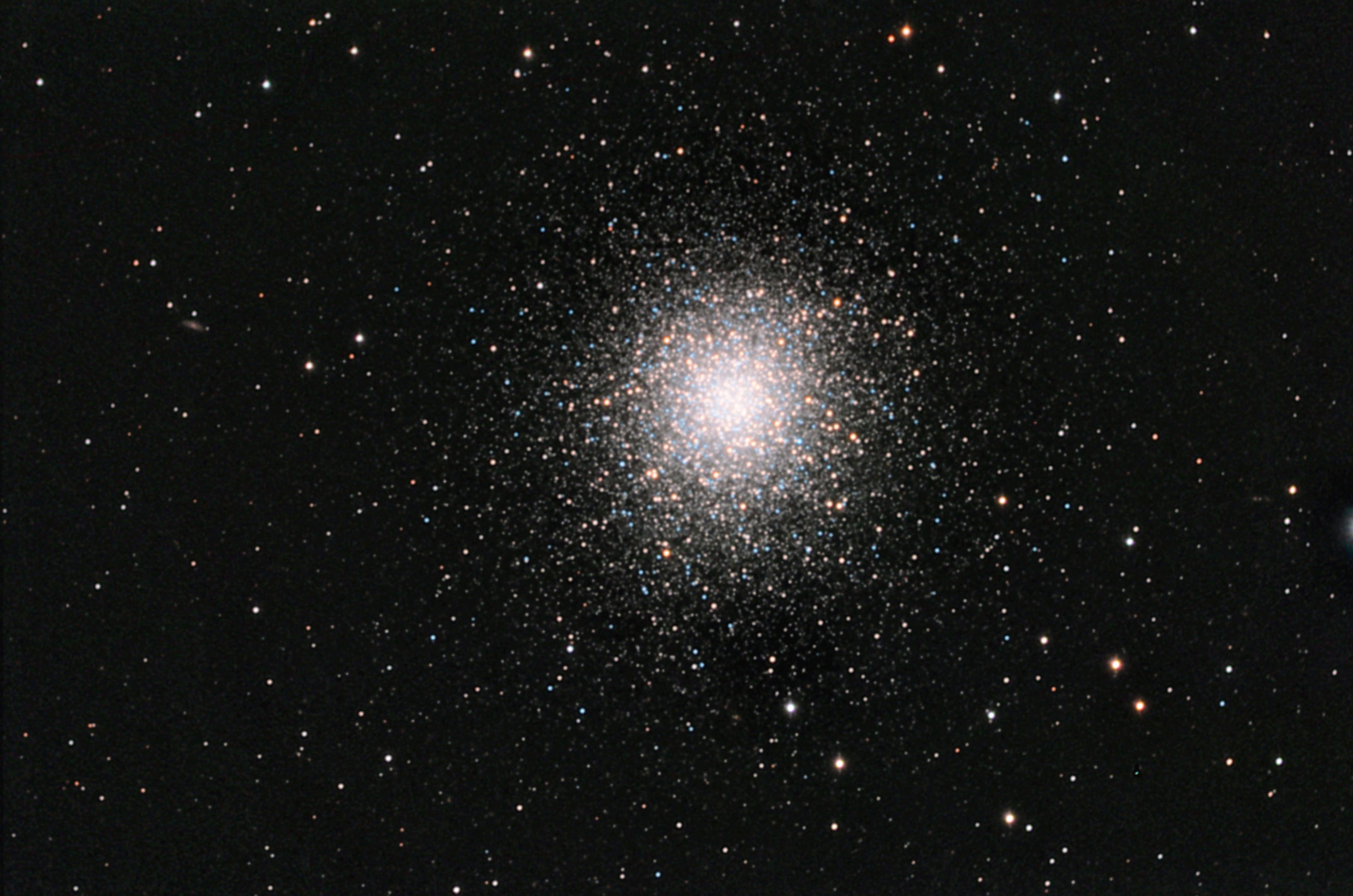50 Years Ago – Skylab Paved the Way for the International Space Station

Skylab weighed about 100 tons, and its launch marked the last launch of the powerful Saturn V, the rocket that never failed. It had a volume of 283.17 cubic meters and was separated into two "floors;" the "upper" floor contained storage lockers and a large empty space for conducting experiments, and two airlocks, one pointed "down" toward the earth and the other "up" toward the sun; the "lower" floor was divided into rooms including a dining room with a table, three bedrooms, a work area, a bathroom, and a shower. The floors consisted of an open gridwork that fit cleats on the bottom of the astronauts' shoes. The station was also equipped with an airlock module for the many spacewalks that were required to change film in the external cameras and make repairs to the station. The Apollo Command and Service Modules remained attached to the station's docking mechanism for the duration of the astronauts' stays aboard the station. (Image Credit: NASA)
50 Years Ago – Skylab Paved the Way for the International Space Station
The International Space Station (ISS) has been in operation with research ongoing since November 2, 2000. But it was the first US space station, Skylab, that helped pave the way for permanent operations in Low-Earth Orbit (LOE). The three man crew of Charles Conrad, Joseph Kerwin, and Paul Weitz launched aboard a Saturn IB rocket fifty years ago this week, on May 25, 1973. This followed the launch of the unmanned Skylab Space Station a week earlier by a Saturn V on May 14, 1973 – The last launch of the venerable Saturn V booster.
Skylab was hailed as a "bold concept" by Rocco Petrone, who served as director of launch operations at NASA's Kennedy Space Center in Florida before becoming director of the agency's Marshall Space Flight Center in Huntsville, Alabama during 1973 and 1974.
"The program demanded innovation and ingenuity," said Petrone in Skylab, Our First Space Station, a NASA report published in 1977. "Experience and knowledge gained from earlier space programs provided a solid foundation on which to build, but the Skylab Program was truly making new pathways in the sky."
The project began as the Apollo Applications Program in 1968 with an objective to develop science-based human space missions using hardware originally developed for the effort to land astronauts on the moon.
Skylab orbited the Earth from 1973 to 1979. The 169,950-pound space station included a workshop, a solar observatory, a multiple docking adapter, and systems to allow three crews to spend up to 84 days in space. While the space station lifted off unpiloted as Skylab 1 atop a Saturn V launch vehicle, the astronaut crews were launched to orbit by Saturn 1B rockets.
Liftoff of Skylab 1 came on May 14, 1973, but within minutes it was apparent that there was trouble. NASA's Skylab Program Manager William Schneider, filled in the details at a post-launch news conference.
"At approximately 63 seconds into the launch of Skylab 1, there was an indication of premature deployment of the meteoroid protective shield," Schneider said. "If that has happened, the shield was probably torn off. The thermal indications are that it is gone, and we have some indication that our solar array on the workshop also did not fully deploy."
As a result of the uncertainty, launch of Skylab 2 with the crew of Charles Conrad, Joseph Kerwin and Paul Weitz, scheduled for the next day, was postponed.
The NASA-industry team around the country went into action to develop plans and hardware necessary to save Skylab. The astronauts practiced using special tools to remove material that jammed the remaining solar array to allow it to provide Skylab with the needed electrical power. A square thermal shield, which operated like a sunshade, also was developed to protect the station from the heat of the sun.
The crew launched May 25, 1973 aboard an Apollo command-service module and mission commander Conrad expressed confidence that their preparations would pay off right away.
"This is Skylab 2, we fix anything," he said at the moment of liftoff.
The crew deployed the new solar shield through a small scientific experiment airlock, located in the side of the workshop normally facing the sun. Once outside, the shield popped open like a parasol, with four struts extending outward from a segmented center post. Temperatures inside the lab soon reduced to near-normal levels.
Next came the spacewalk to free the jammed solar away. After considerable work, Kerwin was able to cut the metal that had jammed the solar wing in a folded position. Using a rope sling, Conrad forced the array beam to deploy. Full extension of the solar panel occurred later, providing electrical power crucial for the three planned piloted missions.
With the Skylab 2 mission back on track, the crew focused on the primary goals of the program -- studies in materials processing in microgravity, Earth observations, expanding knowledge of solar astronomy, and proving that humans could live and work in space for extended periods.
The longest American spaceflight at that point was the 14-day mission of Gemini 7 astronauts Frank Borman and James Lovell. Skylab 2 would double that record and show that the astronauts adapted well.
"Mobility around here is super," Conrad said. "Every kid in the United States would have a blast up here."
Following splashdown in the Pacific Ocean and recovery of the Skylab 2 Apollo capsule on June 22, 1973, NASA Administrator James Fletcher had high praise for the crew and the entire agency-industry team.
"For the first time, a crew of astronauts has returned from an extended tour in a space laboratory," he said. "Essentially all of the objectives for this mission have been completed."
Skylab 3 launched the second crew on July 28, 1973, with Alan Bean, Owen Garriott and Jack Lousma aboard.
Early in the mission, Garriott and Lousma performed a spacewalk to erect a new twin-pole solar shield that provided better thermal control for the remainder of the Skylab missions.
The second crew returned to Earth Sept. 25, 1973, following 59 days in orbit.
Skylab 4 originally was planned for a mission of about the same length. When the final Skylab expedition was extended to 80 days or more, NASA's Preflight Operations Branch at Kennedy, under Raul "Ernie" Reyes, was given the challenge to squeeze another 980 pounds of food, film and equipment into the Apollo command module. Using Reyes' "a place for everything, and everything in its place" philosophy, his team succeeded in using every cubic inch of storage space.
On Nov. 16, 1973, astronauts Gerald Carr, Edward Gibson, and William Pogue lifted off. During their 84-day mission, the Skylab 4 crew continued the comprehensive research programs.
All three expeditions produced a vast study of the Earth -- its crops, weather, and changes in environment. They also completed a revealing study of the Sun, while crews manufactured alloys, grew perfect crystals, and learned to work in space.
Following splashdown and recovery on Feb. 8, 1974, Fletcher stressed the importance of Skylab's accomplishments for the future of human spaceflight.
"It has moved the space program from the realm of the spectacular, into a new phase that can be characterized possibly as almost businesslike," he said. "It has contributed to an orderly transition from the Apollo era to the Space Shuttle."
Skylab 3 pilot Jack Lousma noted that the program helped pave the way for long-duration missions in low-Earth orbit as well as to Mars and beyond.
"Flights of 28, 59, and 84 days were forerunners of what we are doing now aboard the International Space Station," he said. "The fact that we could work in space for longer periods is one of the things we were able to prove during Skylab."
For more information:
https://www.nasa.gov/feature/50-years-ago-the-launch-of-skylab-americas-first-space-station
https://www.nasa.gov/feature/50-years-ago-skylab-2-the-we-fix-anything-crew
https://history.nasa.gov/apollo/skylab.html
https://www.nasa.gov/content/40-years-ago-skylab-paved-way-for-international-space-station
https://astromart.com/news/show/the-world-celebrates-60-years-of-human-space-flight
https://astromart.com/news/show/kennedy-space-center-celebrates-50-years-of-success
https://astromart.com/news/show/happy-birthday-nasa-50-years-of-the-right-stuff
Astromart News Archives:
https://www.astromart.com/news/search?category_id=3&q=.
Check out some of my favorite Words of Wisdom:
https://astromart.com/news/show/words-of-wisdom-my-favorite-quotable-quotes
https://astromart.com/news/show/words-of-wisdom-my-favorite-proverbs-from-around-the-world
Do you enjoy reading these postings?
Then click here and buy the Astromart staff a cup of coffee (and maybe even some donuts):
https://astromart.com/support-options
Funding Member
Sponsors
- ASTROPHOTOGRAPHY BY MARTIN PUGH
- AstroMart LLC
- Waite Research
- RemoteSkies.net
- APM-Telescopes
- OMI OPTICS USA LLC
- astronomy-shoppe
- BW
- SellTelescopes.com
- Bob's Knobs
- BBLABS LLC
- Anacortes Telescope
- Rouz Astro
- Astromart Customer Service
- Matsumoto Company
- FocusKnobs
- Desert Sky Astro Products
View all sponsors



